Are you ready to torch fat and achieve your weight loss goals without any fancy equipment? If so, then you’re in for an intense and effective workout that will leave you sweating and exhilarated. As an expert weight loss trainer, I’m here to guide you through a high-intensity interval training (HIIT) routine specifically designed for fat loss, and the best part is, you don’t need any equipment! In this article, we’ll dive into the world of HIIT and explore a non-equipment workout that will help you shed those extra pounds and improve your overall fitness. Get ready to push your limits, boost your metabolism, and embark on a journey towards a healthier, leaner you. Let’s jump right in!
Understanding HIIT
High-Intensity Interval Training (HIIT) is a workout technique that has gained immense popularity over the years. HIIT involves short bursts of high-intensity exercise followed by periods of rest or low-intensity exercise. This form of exercise has been shown to be highly effective in achieving fitness goals.
HIIT has been found to be highly effective in improving cardiovascular health, increasing muscle mass, and reducing body fat levels. A study by the Journal of Strength and Conditioning Research showed that HIIT workouts can burn up to 30% more calories than other forms of exercise.
One of the most significant benefits of HIIT is that it can be completed in a shorter amount of time compared to traditional cardio workouts. A typical HIIT workout can last anywhere from 10 to 30 minutes, making it an ideal option for busy individuals.
Moreover, HIIT has been shown to improve insulin sensitivity, which can help prevent type 2 diabetes. It can also boost metabolism and improve overall athletic performance. HIIT is a highly effective way to challenge your body and switch up your fitness routine.
Incorporating HIIT into your exercise routine can provide numerous health benefits, including but not limited to, improved cardiovascular health, increased muscle mass, and reduced body fat levels. By taking up HIIT, you can achieve your fitness goals in less time while improving your overall health and well-being. However, before starting any new exercise program, it is crucial to consult with a healthcare professional.
Benefits of HIIT for Fat Loss
1. Efficient Calorie Burning:
HIIT workouts are known for their ability to burn a significant number of calories in a short period. A study published in the Journal of Strength and Conditioning Research found that participants who engaged in HIIT burned approximately 25-30% more calories than those who performed steady-state cardio exercises.
This increased calorie burn is attributed to the intense bursts of activity during HIIT, which elevate your heart rate and engage multiple muscle groups simultaneously. The combination of high-intensity intervals and short recovery periods creates a metabolic demand that leads to a greater caloric expenditure during and after the workout.
This calorie-burning effect has been shown to persist even hours after the exercise session, thanks to the phenomenon of excess post-exercise oxygen consumption (EPOC), also known as the “afterburn” effect.
2. Accelerated Fat Loss:
If your goal is to reduce body fat, particularly in the abdominal area, HIIT can be a highly effective strategy. Research published in the International Journal of Obesity demonstrated that HIIT significantly reduced overall body fat and visceral fat (fat stored around the organs) in a group of overweight individuals.
The short, intense intervals in HIIT workouts stimulate fat oxidation and metabolic adaptations that promote fat loss. These intense efforts trigger a higher demand for energy, leading the body to utilize stored fat as a fuel source.
Additionally, HIIT has been shown to increase the production of growth hormone, which plays a role in fat metabolism and muscle preservation.
3. Preserved Lean Muscle Mass:
One concern often associated with weight loss is the potential loss of lean muscle mass. However, HIIT workouts have the advantage of preserving muscle while promoting fat loss.
A study published in the Journal of Applied Physiology showed that participants who engaged in HIIT preserved more muscle mass compared to those who performed steady-state cardio exercises. This preservation of lean muscle mass is crucial because muscle plays a vital role in maintaining a higher metabolic rate.
The more muscle you have, the more calories you burn at rest. By incorporating HIIT into your routine, you can help maintain and even enhance your muscle mass, leading to long-term metabolic benefits.
4. Enhanced Metabolic Rate:
One of the significant benefits of HIIT is its ability to elevate your metabolic rate for an extended period after the workout. The heightened metabolic rate is attributed to the EPOC effect, where your body continues to burn calories at an elevated rate even when you’re done exercising.
A study published in the Journal of Translational Medicine found that HIIT resulted in a significantly higher EPOC compared to continuous moderate-intensity exercise. This extended calorie burn can contribute to fat loss over time and may help create a more favorable environment for weight management.
5. Improved Insulin Sensitivity:
Insulin sensitivity, the body’s ability to respond to and utilize insulin effectively, is a crucial factor in managing weight and preventing chronic diseases like type 2 diabetes. Multiple studies have shown that HIIT can improve insulin sensitivity.
For example, a study published in the Journal of Obesity demonstrated that HIIT workouts improved insulin sensitivity and glucose metabolism in overweight women. The intense bursts of exercise in HIIT sessions elicit powerful metabolic responses, promoting better blood sugar control and reducing insulin resistance.
By enhancing insulin sensitivity, HIIT not only aids in weight management but also reduces the risk of weight gain and related metabolic disorders.
Preparing for the Workout
Preparation is key to ensuring a safe and effective session that will leave you feeling energized and accomplished. In this section, we’ll explore essential steps to help you prepare for a HIIT workout, backed by research and expert advice.
1. Hydration:
Proper hydration plays a critical role in optimizing your performance during a HIIT workout. Dehydration, even in mild forms, can have negative effects on your exercise capacity and overall well-being.
Research has shown that losing just 2% of your body weight in fluids can lead to a decrease in exercise performance. To ensure you’re adequately hydrated, it’s recommended to drink water throughout the day leading up to your workout.
Aim for at least 8-10 cups (64-80 ounces) of water daily, but individual needs may vary depending on factors such as body size, activity level, and environmental conditions. About 30 minutes before your HIIT session, have a glass of water to top up your hydration levels.
During the workout, listen to your body’s thirst cues and take regular sips of water to maintain proper hydration. By staying hydrated, you’ll optimize your exercise performance, support nutrient delivery to your muscles, and help regulate your body’s temperature during the intense activity of HIIT.
2. Proper Nutrition:
Fueling your body with the right nutrients is essential for sustaining energy levels and maximizing the benefits of your HIIT workout. A balanced meal or snack before your session can provide the necessary fuel to perform at your best.
Carbohydrates are a primary source of energy, and consuming them before exercise has been shown to improve performance and delay fatigue. Opt for complex carbohydrates like whole grains, fruits, and vegetables, which provide a slow and steady release of energy.
Pair your carbohydrates with a source of protein to support muscle repair and recovery. Research has demonstrated that the combination of carbohydrates and protein before exercise can enhance muscle protein synthesis and promote better recovery.
Consider options like a banana with nut butter, Greek yogurt with fruit, or a whole-grain wrap with lean protein. Experiment with different pre-workout meals and find what works best for you, allowing enough time for digestion before your workout.
It’s important to note that individual preferences and sensitivities may vary, so listen to your body and choose foods that provide sustained energy without causing discomfort.
3. Dynamic Warm-up:
Before engaging in the intense intervals of a HIIT workout, it’s crucial to warm up your muscles and increase your heart rate gradually. A dynamic warm-up routine that includes a variety of movements can help prepare your body for the demands of the workout.
Start with light cardio exercises like jogging in place, jumping jacks, or skipping rope to elevate your heart rate. Then incorporate dynamic stretches and movements that target major muscle groups. Examples include arm circles, leg swings, high knees, lunges, and bodyweight squats.
Research has shown that dynamic warm-ups enhance flexibility, increase range of motion, improve muscular performance, and help prevent injuries. Aim to spend 5-10 minutes on a dynamic warm-up, gradually increasing the intensity as you progress through the exercises.
This will activate your muscles, increase blood flow, and improve your overall workout performance. Remember that the warm-up should be specific to the movements and muscles you’ll be using during your HIIT session.
4. Form and Technique:
Maintaining proper form and technique throughout your HIIT workout is crucial for maximizing results and reducing the risk of injuries. Each exercise in a HIIT routine has specific movement patterns and muscle activation requirements.
It’s essential to focus on executing each exercise with correct alignment, engaging the targeted muscle groups, and avoiding compensatory movements. Poor form can lead to strain on joints, muscles, and connective tissues, increasing the likelihood of injuries and diminishing the effectiveness of the workout.
If you’re new to HIIT or unsure about proper form, consider seeking guidance from a certified fitness professional or using reputable instructional resources. Take your time to learn and understand the correct technique for each exercise, paying attention to body positioning, range of motion, and muscle activation.
Practicing good form will not only enhance your workout efficiency but also promote muscle balance, strength development, and injury prevention.
Don’t hesitate to start with lower intensity or modified versions of exercises until you feel comfortable with the proper form, and gradually progress as your body adapts.
5. Modify and Listen to Your Body:
While HIIT workouts are known for their intensity, it’s crucial to listen to your body and make necessary modifications during the session. Everyone has unique fitness levels, strengths, and limitations, and it’s important to respect your body’s signals.
If an exercise feels too challenging or causes discomfort, don’t hesitate to modify the movement or choose an alternative exercise that targets the same muscle groups. This might involve reducing the intensity, adjusting the range of motion, or opting for lower impact variations.
Remember, it’s better to prioritize safety and gradually progress at your own pace rather than pushing yourself beyond your limits and risking injury. HIIT workouts can be tailored to accommodate different fitness levels and abilities, making them accessible to a wide range of individuals.
As you gain strength, endurance, and familiarity with the exercises, you can gradually increase the intensity and duration of your workouts. Be patient with yourself, and focus on gradual improvements over time.
Celebrate your progress and embrace the journey towards your fitness goals.
Warm-Up Exercises
A proper warm-up is essential before diving into the intense intervals of a high-intensity interval training (HIIT) workout.
It helps prepare your body for the demands of the workout, increases your heart rate gradually, and improves your overall performance.
In this section, we’ll explore a variety of dynamic warm-up exercises that are commonly used in HIIT workouts, backed by research and expert advice.
Jumping Jacks:
Jumping jacks are a fantastic choice for a dynamic warm-up before your HIIT workout. This classic exercise engages multiple muscle groups, increases heart rate, and prepares your body for the intense intervals ahead.
To perform jumping jacks, start by standing tall with your feet together and arms by your sides. Simultaneously jump your feet out to the sides while raising your arms overhead. As you land, quickly reverse the movement by bringing your feet back together and lowering your arms to the starting position. Repeat this motion in a rhythmic and controlled manner.
Jumping jacks effectively increase blood flow, warm up your muscles, and improve joint mobility. They activate your legs, core, shoulders, and arms, making it an excellent full-body warm-up exercise.
During your warm-up, aim to perform jumping jacks for 1-2 minutes to gradually elevate your heart rate and increase body temperature. Focus on maintaining proper form and a steady pace throughout the exercise.
Arm Circles:
Arm circles are a simple and effective warm-up exercise that can be incorporated into a no-equipment HIIT workout. They help to mobilize and activate the muscles in your shoulders, upper back, and arms, preparing them for the intense movements ahead.
Here’s how to perform arm circles as part of your warm-up:
- Stand with your feet shoulder-width apart, and extend your arms straight out to the sides, parallel to the floor.
- Begin making small circles with your arms, moving them forward in a controlled and fluid motion. Start with a slow pace and gradually increase the speed as you feel your muscles warming up.
- Continue the forward arm circles for about 20-30 seconds, focusing on maintaining good posture and engaging your core.
- After the specified time, switch to making circles in the opposite direction, moving your arms backward. Again, start slowly and gradually increase the speed.
- Perform backward arm circles for another 20-30 seconds.
- You can also vary the size of the circles, starting with smaller circles and gradually increasing the diameter as you go.
Arm circles are an excellent warm-up exercise as they increase blood flow to the targeted muscles, improve joint mobility, and enhance overall range of motion.
They help to prevent injuries, reduce muscle stiffness, and mentally prepare you for the upcoming HIIT workout. Remember to listen to your body, start with smaller circles if needed, and gradually progress to larger circles and faster speeds as your muscles warm up.
High Knees:
High knees are an excellent warm-up exercise for a no-equipment HIIT workout. They effectively elevate your heart rate, activate your leg muscles, and prepare your body for the intense intervals ahead. Here’s how to perform high knees as part of your warm-up:
- Stand with your feet hip-width apart, arms hanging naturally by your sides.
- Lift your right knee up towards your chest as high as possible, while simultaneously raising your left arm.
- Lower your right leg back down and quickly repeat the movement with your left knee and right arm.
- Continue alternating the movement, lifting your knees and swinging your arms in a running motion.
- Aim to perform high knees at a fast pace, engaging your core muscles and maintaining good posture.
- Start with a slower pace and gradually increase your speed as you warm up.
Perform high knees for about 1-2 minutes to raise your heart rate, increase blood flow, and prepare your muscles for the upcoming HIIT exercises. Remember to maintain a controlled and fluid motion throughout the exercise.
High knees are a versatile and effective warm-up exercise that can be included in any no-equipment HIIT routine.
Butt Kicks:
Butt kicks are a great warm-up exercise for a no-equipment HIIT workout. They target the lower body muscles, increase heart rate, and prepare your body for more intense movements. Here’s how to perform butt kicks:
- Stand with your feet hip-width apart and arms relaxed by your sides.
- Begin jogging in place while focusing on lifting your heels up towards your glutes.
- Alternate legs and aim to kick your buttocks with each heel as you jog.
- Keep your upper body upright and engage your core for stability.
- Continue performing butt kicks for 30-60 seconds to warm up your leg muscles and increase blood flow.
Butt kicks help to activate the quadriceps, hamstrings, and calves while improving flexibility and range of motion in the lower body. They are an effective way to start your HIIT workout and prepare your muscles for more challenging exercises.
Bodyweight Squats:
Bodyweight squats can be an excellent warm-up exercise for a HIIT workout without any equipment. They help activate the lower body muscles, increase blood flow, and prepare your body for the intense intervals ahead. Here’s how to perform bodyweight squats as part of your warm-up routine:
- Stand with your feet shoulder-width apart, toes slightly pointed outward.
- Engage your core muscles by pulling your belly button towards your spine.
- Slowly lower your body by bending your knees and pushing your hips back, as if you’re sitting into a chair.
- Keep your chest up, back straight, and knees in line with your toes.
- Lower yourself until your thighs are parallel to the ground or as low as comfortable, without letting your knees collapse inward.
- Pause for a moment at the bottom of the squat.
- Push through your heels and extend your legs to return to the starting position.
- Repeat the movement for a set number of repetitions or for a specified duration.
During the warm-up, perform bodyweight squats at a controlled pace, focusing on proper form and engaging the target muscles. Aim to complete 10-15 repetitions or continue for 30-60 seconds.
Lunges:
Lunges are a great exercise to incorporate into your warm-up for a no-equipment HIIT workout. Lunges not only help to activate and warm up the lower body muscles but also improve mobility and stability. Here’s how you can include lunges in your warm-up routine:
- Forward Lunges: Start by standing tall with your feet hip-width apart. Take a big step forward with your right foot and lower your body into a lunge position. Your right knee should be bent at a 90-degree angle, and your left knee should hover just above the ground. Push through your right heel and return to the starting position. Repeat on the other leg. Perform 8-10 lunges on each leg.
- Reverse Lunges: Stand with your feet hip-width apart. Take a step back with your right foot and lower your body into a lunge position. Both knees should be bent at 90-degree angles. Push through your left heel and return to the starting position. Repeat on the other leg. Perform 8-10 lunges on each leg.
- Side Lunges: Stand with your feet wider than hip-width apart, toes pointing forward. Shift your weight to the right side and lower your body into a side lunge, bending your right knee and keeping your left leg straight. Push through your right heel and return to the starting position. Repeat on the other side. Perform 8-10 lunges on each side.
- Walking Lunges: Start by standing tall with your feet together. Take a big step forward with your right foot and lower your body into a lunge position. Push through your right heel and bring your left foot forward, stepping into another lunge. Continue walking forward, alternating legs with each step. Perform 8-10 lunges on each leg.
Performing lunges as part of your warm-up routine helps to increase blood flow, activate the muscles, and prepare your body for the upcoming HIIT workout.
HIIT Workout Routine
Perform each exercise for 45 seconds, followed by a 15-second rest. Complete three rounds of the circuit.
Burpees:
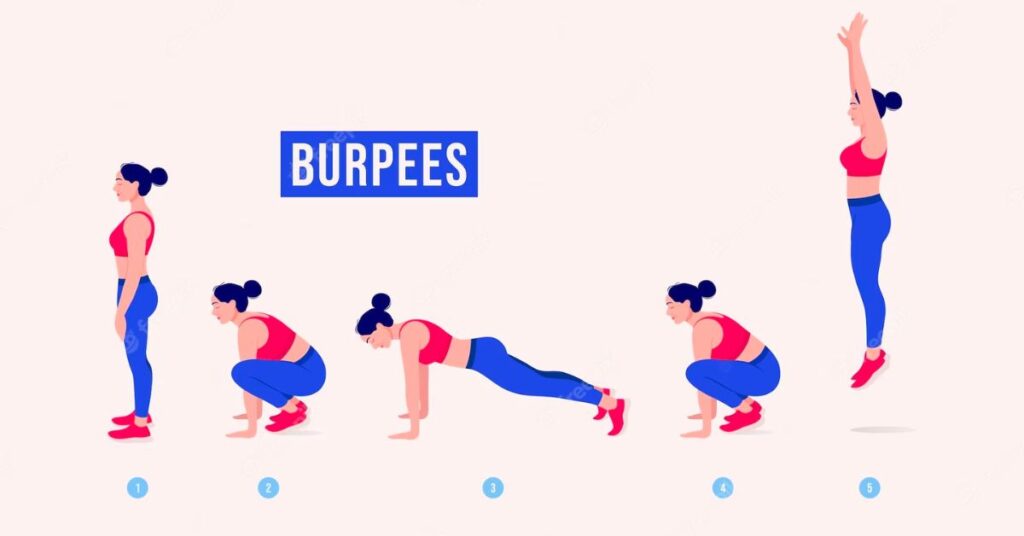
Burpees are an excellent exercise to include in your main HIIT workout routine. They are a full-body exercise that engages multiple muscle groups and elevates your heart rate, making them highly effective for fat burning and cardiovascular conditioning. Here’s how you can incorporate burpees into your HIIT workout:
- Start in a standing position with your feet shoulder-width apart.
- Lower your body into a squat position, placing your hands on the floor in front of you.
- Kick your legs back, extending them behind you, into a push-up position.
- Immediately jump your feet forward, landing them outside your hands.
- Explosively jump upwards, extending your arms overhead.
- Land softly and return to the squat position, repeating the exercise for the desired duration or number of repetitions.
To make your burpees more challenging, you can incorporate variations such as adding a push-up when in the push-up position, performing a tuck jump at the end of the jump, or incorporating a lateral jump when returning to the squat position.
When performing burpees, it’s important to maintain proper form and technique:
- Keep your core engaged throughout the exercise to support your lower back.
- Land softly on the balls of your feet to reduce impact on your joints.
- Focus on a smooth and controlled movement, avoiding jerky or rushed motions.
In your HIIT workout, you can include burpees as one exercise in a circuit or perform them in intervals, such as 45 seconds of burpees followed by 15 seconds of rest. Aim to complete multiple rounds or intervals to challenge yourself and maximize the fat-burning benefits of this high-intensity exercise.
Mountain climbers:
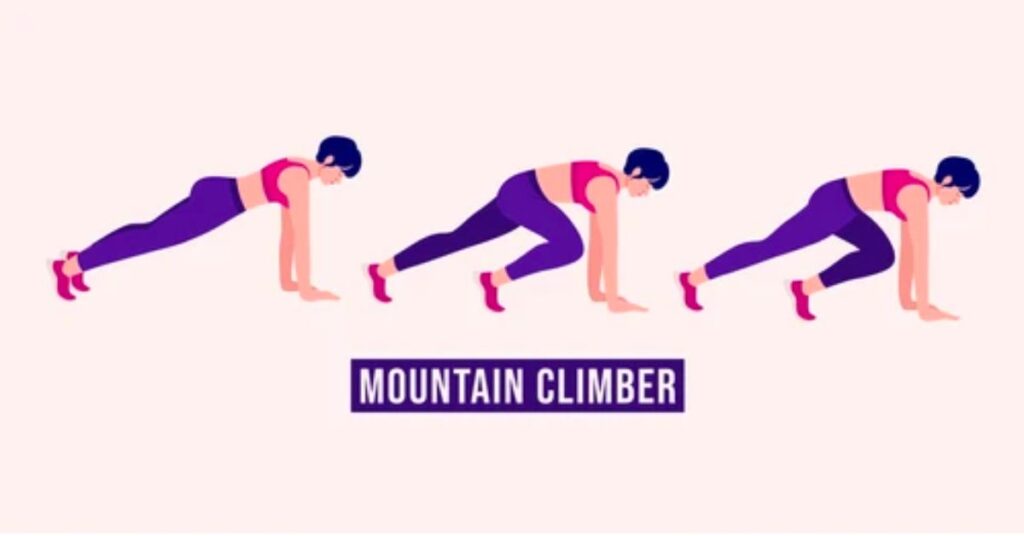
Mountain climbers are an excellent exercise to include in your main HIIT workout routine. They are a challenging full-body movement that engages multiple muscle groups and elevates your heart rate. Here’s how you can incorporate mountain climbers into your HIIT workout:
- Starting Position: Begin in a high plank position with your hands shoulder-width apart and your body forming a straight line from head to heels. Engage your core and keep your shoulders, hips, and ankles aligned.
- Movement: Drive one knee toward your chest, keeping your foot off the ground. As you bring one knee in, quickly switch legs, extending the bent leg back and bringing the opposite knee toward your chest. Imagine as if you’re running in place horizontally, but in a plank position.
- Tempo and Intensity: Perform the mountain climbers at a fast and controlled pace. Aim for a rapid, alternating movement of the legs, driving the knees toward the chest with each switch. Maintain a consistent rhythm throughout the exercise.
- Duration: Set a timer or perform the mountain climbers for a specific time duration, such as 30 seconds or 1 minute, depending on your fitness level and workout goals. As you progress, you can increase the duration or incorporate intervals with other exercises.
- Modifications: If you need to modify the exercise due to fitness level or any limitations, you can perform a slower version of the movement by bringing one knee toward the chest at a time, rather than switching legs in a rapid motion.
- Sets and Rest: Include mountain climbers as part of a circuit or perform them consecutively for a set number of repetitions or time. Take a short rest period, usually around 15-30 seconds, between sets or exercises to recover and maintain proper form.
Mountain climbers are an effective HIIT exercise because they engage the core, shoulders, arms, and legs, providing a total body workout. They also elevate your heart rate, helping to improve cardiovascular fitness and burn calories.
Jump squats:
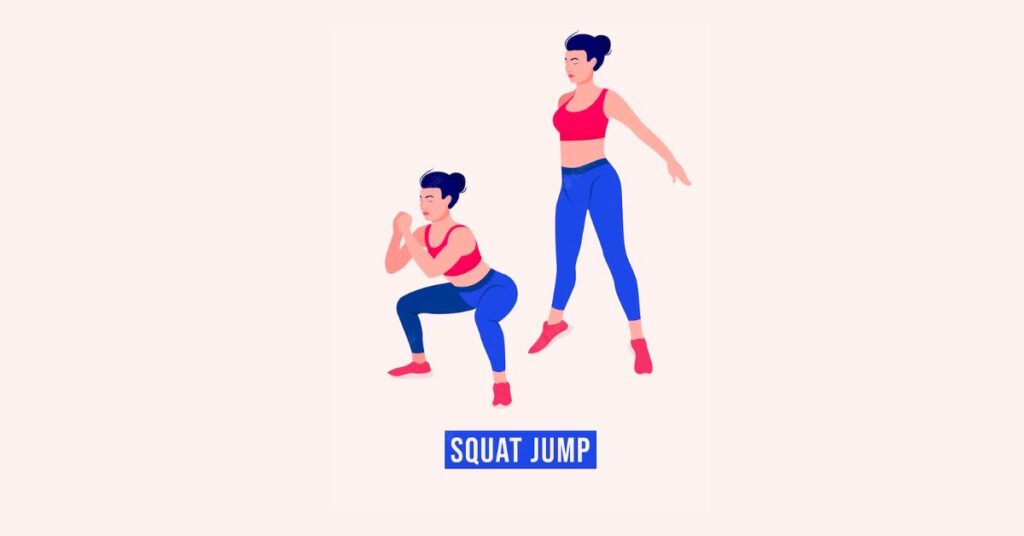
Jump squats are an excellent exercise to include in your main HIIT workout routine. They target multiple muscle groups, increase heart rate, and provide an intense cardiovascular challenge. Here’s how you can incorporate jump squats into your HIIT workout:
- Starting Position: Stand with your feet shoulder-width apart and toes slightly turned out. Engage your core, keep your chest lifted, and maintain a neutral spine throughout the exercise.
- Squat: Lower your body down into a squat position by bending your knees and pushing your hips back. Aim to get your thighs parallel to the ground while keeping your heels flat on the floor. Keep your knees tracking in line with your toes.
- Explosive Jump: From the squat position, explode upward by extending your hips, knees, and ankles simultaneously. Jump as high as you can while reaching your arms overhead for maximum height and power.
- Landing: Land softly and quietly, absorbing the impact by bending your knees and hips. Maintain control and stability in your landing to protect your joints.
- Repeat: Immediately go back into another squat and repeat the jump squat movement for the desired number of repetitions or for a specific time interval.
During the jump squat exercise, focus on maintaining proper form and technique. Keep your knees aligned with your toes, chest lifted, and core engaged to protect your joints and maximize the benefits. To make the workout more challenging, you can increase the speed and height of your jumps or add variations like tuck jumps or squat jump pulses.
High plank jacks:

High plank jacks are an excellent exercise to include in your main HIIT workout routine. They target multiple muscle groups and elevate your heart rate, making them effective for burning calories and improving cardiovascular fitness. Here’s how you can perform high plank jacks:
- Start in a high plank position with your hands directly under your shoulders and your body in a straight line from head to heels.
- Engage your core muscles by pulling your belly button toward your spine and squeezing your glutes.
- From the high plank position, jump both feet wide apart, as if performing a jumping jack motion. Keep your core stable and maintain a strong plank position throughout the movement.
- Immediately jump your feet back together, returning to the starting position.
- Continue performing the movement at a controlled and challenging pace for the designated duration of the exercise (e.g., 45 seconds).
- Maintain proper form by avoiding sagging or lifting your hips and keeping your wrists directly under your shoulders.
- To modify the exercise, you can perform a step tap instead of jumping, moving one foot out to the side at a time.
- Perform 3 rounds of high plank jacks, with a 15-second rest between each round.
High plank jacks are a dynamic and intense exercise that engage your core, shoulders, chest, and legs. They also improve your coordination and agility.
Alternating reverse lunges:
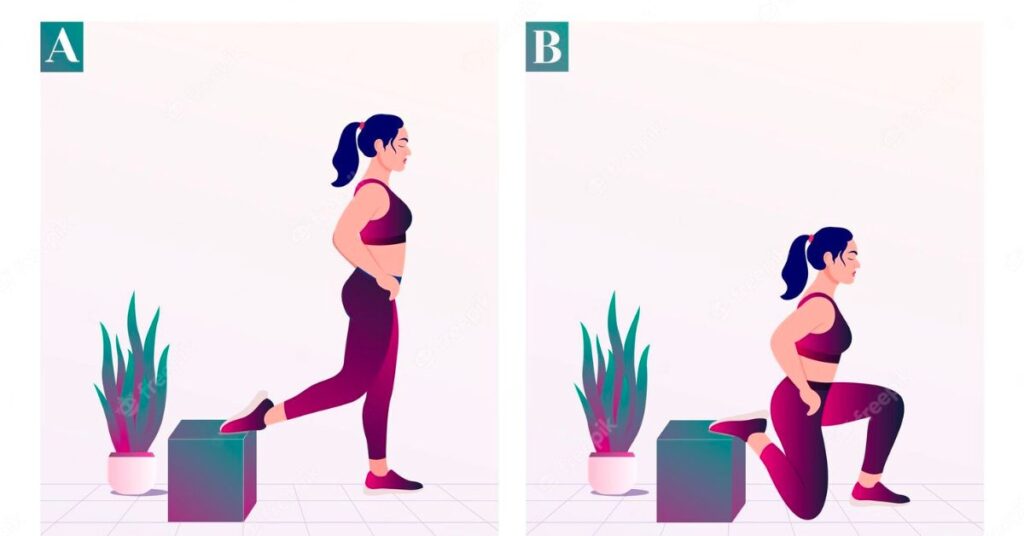
Alternating reverse lunges are an excellent exercise to include in your main HIIT workout routine. They target multiple muscle groups, increase heart rate, and promote fat burning. Here’s how you can incorporate alternating reverse lunges into your HIIT workout:
- Start by standing tall with your feet hip-width apart and your hands on your hips or extended in front of you for balance.
- Take a step backward with your right foot, lowering your body into a lunge position. Your right knee should be just above the ground, and your left knee should be bent at a 90-degree angle, positioned directly above your left ankle.
- Push through your left heel and bring your right foot forward, returning to the starting position.
- Now, take a step backward with your left foot, lowering into a lunge position on the opposite side. Your left knee should be just above the ground, and your right knee should be bent at a 90-degree angle.
- Push through your right heel and bring your left foot forward, returning to the starting position.
- Continue alternating between the right and left legs, performing reverse lunges for a set amount of time, such as 45 seconds, or a specific number of repetitions, such as 10-12 lunges on each leg.
- To intensify the exercise, you can add an explosive jump between lunges, known as jump reverse lunges. After pushing through the front heel and returning to the starting position, explosively jump into the air and switch legs mid-air, landing in a lunge position with the opposite leg forward.
- Repeat the alternating reverse lunges or jump reverse lunges for the desired number of sets, resting for 15-30 seconds between sets.
Alternating reverse lunges in your HIIT workout routine engage the quadriceps, hamstrings, glutes, and calf muscles, helping to strengthen and tone your lower body.
Bicycle crunches:
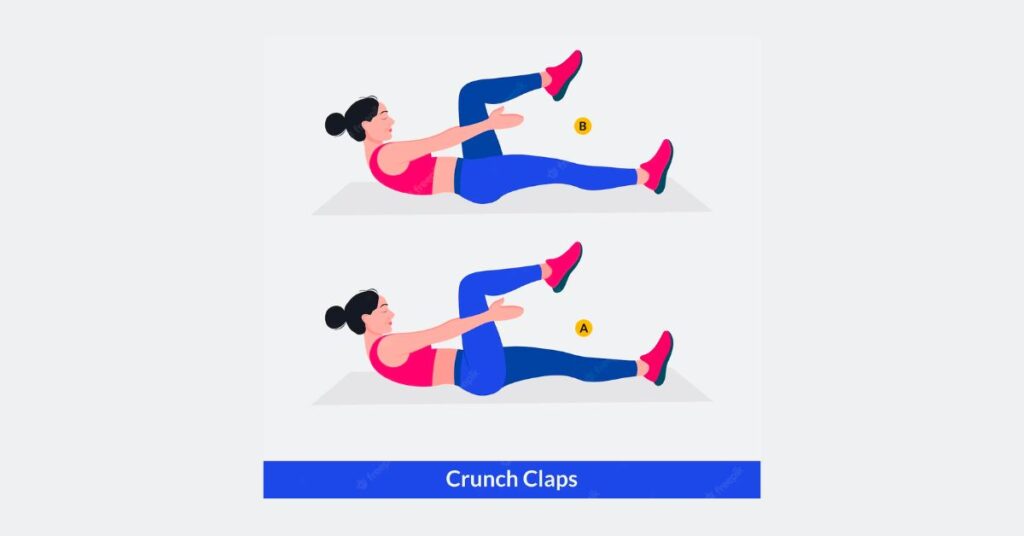
Bicycle crunches are an excellent exercise to include in your main HIIT workout routine. They target the abdominal muscles and provide a challenging cardiovascular component. Here’s how you can perform bicycle crunches as part of your HIIT workout:
- Lie flat on your back with your hands behind your head, elbows pointing out to the sides. Lift your shoulder blades off the ground, engaging your core.
- Bring your knees up to a tabletop position, with your thighs perpendicular to the ground and your shins parallel to the ground.
- As you exhale, simultaneously twist your torso to bring your right elbow towards your left knee, extending your right leg out straight. Keep your left knee bent and close to your chest.
- Inhale and return to the starting position.
- As you exhale again, twist your torso to bring your left elbow towards your right knee, extending your left leg out straight. Keep your right knee bent and close to your chest.
- Continue alternating sides in a fluid and controlled motion, as if pedaling a bicycle.
To incorporate bicycle crunches into your HIIT workout routine, follow these steps:
- Set a timer for your desired work-to-rest intervals. For example, you can perform bicycle crunches for 45 seconds and rest for 15 seconds.
- Start with a brief warm-up to prepare your body for the workout.
- Begin the HIIT circuit by performing bicycle crunches at a high intensity for the specified work duration. Focus on maintaining proper form and engaging your core muscles.
- After completing the work interval, take the designated rest period to recover and prepare for the next exercise or round.
- Repeat the cycle of bicycle crunches and rest for the desired number of rounds, typically 2-4 rounds, depending on your fitness level and workout duration.
Bicycle crunches in a HIIT format help to elevate your heart rate, engage the abdominal muscles, and contribute to calorie burning and fat loss.
Cool-Down Exercises
Cooling down after a HIIT workout is essential for gradually bringing your heart rate back to its resting state and allowing your body to recover. Here are some cool-down exercises you can incorporate:
- Walking: Begin by walking slowly, gradually decreasing your pace. Focus on taking deep breaths and allowing your heart rate to gradually lower.
- Low-Intensity Cardio: Transition to low-intensity cardio exercises such as light jogging, cycling, or using an elliptical machine. Maintain a comfortable pace for 5-10 minutes to continue promoting blood flow and facilitate the removal of metabolic waste products.
- Stretching: Perform static stretches to target the major muscle groups you worked during the HIIT workout. Hold each stretch for 15-30 seconds without bouncing. Focus on your hamstrings, quadriceps, calves, hips, chest, shoulders, and back. You can include stretches like hamstring stretches, quad stretches, calf stretches, hip flexor stretches, chest stretches, and shoulder stretches.
- Deep Breathing: Incorporate deep breathing exercises to promote relaxation and reduce any lingering tension. Inhale deeply through your nose, expanding your abdomen, and exhale slowly through your mouth. Repeat this pattern for several breaths, allowing yourself to unwind and release stress.
- Foam Rolling: If you have a foam roller available, use it to perform self-myofascial release. Roll slowly over different areas of your body, focusing on any tight or sore muscles. Apply gentle pressure to release tension and improve muscle recovery.
Tips for Maximizing Fat Loss
To maximize fat loss with a HIIT workout that requires no equipment, here are some tips to consider:
1. Increasing Intensity:
Pushing yourself to work at a high intensity during the active intervals of your HIIT workout is crucial for maximizing fat loss. By challenging your body with intense bursts of effort followed by short rest periods, you stimulate fat burning and boost your metabolism.
Research published in the Journal of Obesity has shown that high-intensity exercise significantly increases fat oxidation and energy expenditure. The body relies on stored fat as a fuel source during intense exercise, leading to greater fat loss over time.
By consistently pushing yourself to work at a high intensity, you can enhance the effectiveness of your HIIT workouts and achieve your fat loss goals more efficiently.
2. Incorporating Full-Body Movements:
When designing your HIIT routine, it’s beneficial to choose exercises that engage multiple muscle groups simultaneously.
Full-body movements such as burpees, squat jumps, and mountain climbers require significant energy expenditure and increase calorie burn compared to exercises that isolate specific muscles. By incorporating these multi-joint exercises into your routine, you create a greater demand for energy and oxygen, leading to a higher overall fat loss effect.
A study published in the Journal of Strength and Conditioning Research found that HIIT workouts incorporating multi-joint exercises resulted in greater energy expenditure and fat utilization. These exercises also help to improve overall strength and functional fitness.
3. Prioritizing High-Intensity Intervals:
Short but intense intervals should be a priority in your HIIT workouts for maximizing fat loss. Research has consistently shown that shorter bursts of high-intensity exercise can be more effective for fat loss than longer, moderate-intensity intervals.
For example, a study published in the Journal of Applied Physiology demonstrated that performing six sessions of 4-6 sets of 30-second sprints on a stationary bike, spread over two weeks, increased whole-body fat oxidation and improved insulin sensitivity.
By focusing on shorter, more intense intervals, you increase the metabolic demand on your body, promoting greater fat burning during and after the workout.
4. Varying Your Workouts:
To prevent plateauing and keep your body challenged, it’s important to regularly change your HIIT workouts. Introduce new exercises, modify the work-to-rest ratios, or increase the intensity as you progress.
This prevents your body from adapting to the same routine, ensuring ongoing fat loss and continuous improvements in fitness. A study published in the European Journal of Applied Physiology showed that varying the intensity and duration of HIIT sessions resulted in greater fat loss compared to a steady-state cardio program.
By incorporating variety into your workouts, you engage different muscle groups, activate different energy systems, and maintain higher motivation and enjoyment.
5. Consistency:
Consistency is key when it comes to fat loss with HIIT workouts. Aim to incorporate HIIT into your routine at least 2-3 times per week to achieve optimal results.
Research published in the International Journal of Obesity found that a 12-week HIIT program resulted in significant reductions in total body fat and abdominal fat in overweight individuals. Consistent training allows your body to adapt and improve its fat-burning capabilities over time.
By making HIIT a regular part of your fitness routine, you create a sustainable habit that promotes ongoing fat loss and overall health.
6. Combining HIIT with a Balanced Diet:
While HIIT workouts are highly effective for fat loss, it’s important to remember that exercise alone cannot outdo a poor diet. To maximize fat loss, it’s essential to combine your HIIT workouts with a balanced diet consisting of whole, nutrient-dense foods.
Focus on consuming adequate protein, healthy fats, and complex carbohydrates to support muscle recovery, boost your metabolism, and enhanc fat loss. A balanced diet provides the necessary nutrients for your body to function optimally and supports your fitness goals.
By nourishing your body with the right foods, you provide it with the fuel it needs to perform at its best during HIIT workouts and promote sustainable fat loss.
Conclusion
In conclusion, a non-equipment HIIT workout is a highly effective method for fat loss. By incorporating intense bursts of activity and short rest periods, you can maximize calorie burning, accelerate fat loss, preserve muscle mass, enhance your metabolic rate, and improve insulin sensitivity.
To optimize your results, focus on increasing intensity, using full-body movements, prioritizing high-intensity intervals, varying your workouts, maintaining consistency, and combining HIIT with a balanced diet.
With its convenience and accessibility, a no-equipment HIIT workout is a cost-effective and time-efficient way to achieve your fat loss goals and improve overall fitness. Get started today and enjoy the benefits of HIIT for fat loss.

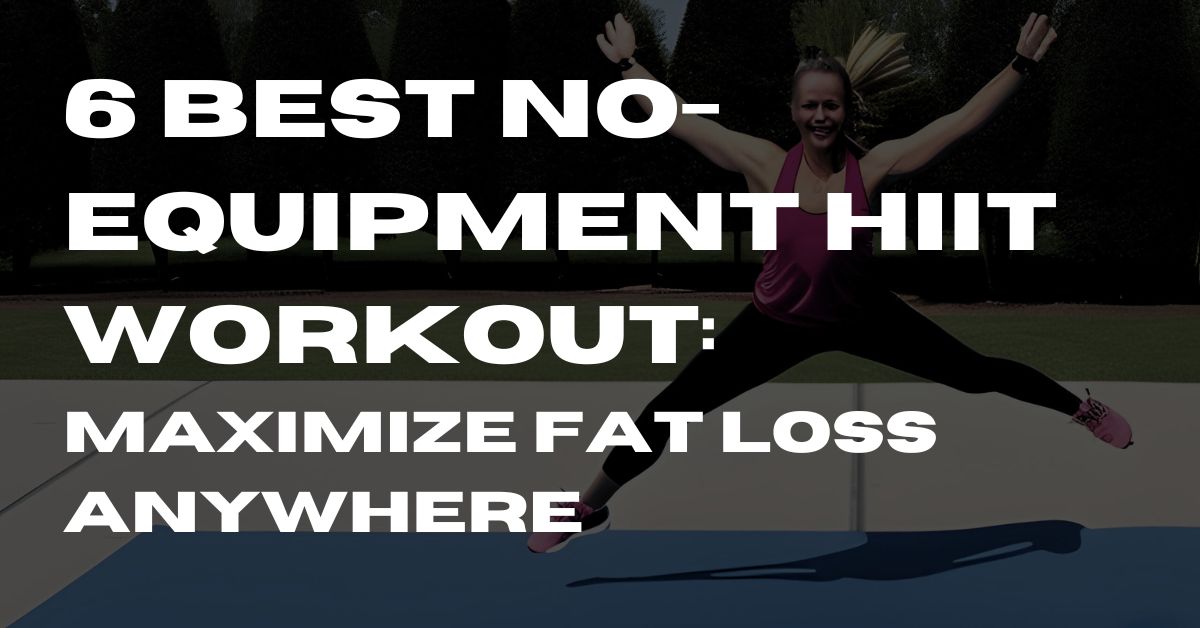
12 thoughts on “6 Best No-Equipment HIIT Workout: Maximize Fat Loss Anywhere”